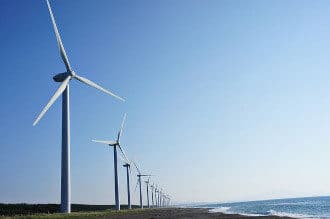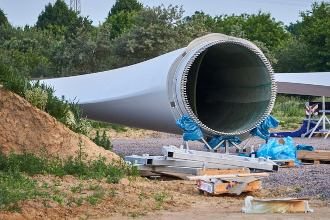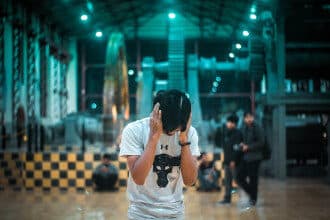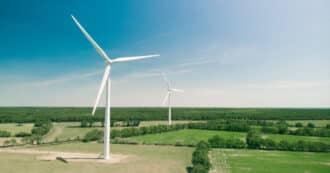By Harry Cooper – Fossil fuels have dominated the energy game since the industrial revolution, but for several decades now we have known about the deadly impacts of fossil fuels and climate change. And with global temperatures rising higher and higher all the time, the call to switch to renewable has never been greater than it is today. One of the more prominent renewables that could potentially help phase out the use of fossil fuels is wind energy.
Switching To Renewables
Wind is a very important form of energy because, even though it may change, it will never stop. This means that wind power is something we can rely on seemingly forever without having to worry about it running out.
Wind power is harnessed through the use of a wind turbine. These large wind turbines are installed in wind power systems, called wind farms, located in areas with strong winds. A massive commercial wind turbine operation such as this can provide power for hundreds of people, but it is not without its flaws.
Wind turbines require lots of space and can only be used practically in areas with large amounts of wind, so space is limited for wind farms. On top of this many people find wind farms a nuisance as they can create noise pollution, and since a wind turbine is so massive, their production creates a large amount of waste.
Luckily, commercial wind farms are not the only way to harness wind power. There are many ways to build a smaller DIY wind turbine at home that can provide power for only a building or two. DIY wind turbines are much smaller and less of a nuisance than traditional wind farming, and can even help you save on energy costs.
Pros of Wind Energy
Clean Energy
The world is slowly trying to decrease their carbon emissions to combat climate change. And wind is one of the most important tools in the fight against global warming.
Burning fossil fuels at our current rate is estimated to release around 33 gigatons of carbon dioxide into the atmosphere every year, but unlike fossil fuels, energy from wind produces virtually no carbon emissions. This has made replacing our current energy sources with wind a great way to try and lower carbon emissions and mitigate climate change.
Perpetual Resource
Wind energy is a type of renewable resource that’s known as a perpetual resource. This means that not only will wind renew itself over time as an energy source, but it will never run out.
Wind is caused by the sun heating the Earth’s surface unevenly causing wind currents. This means that wind will be available for us to use as an energy source for as long as the sun is shining, and using more wind power won’t deplete wind sources.
Wind is Cheap
Wind is not only an efficient use of energy, it is also very cost efficient. In fact, the wind turbine rated one of the cheapest sources of energy available for use in the US today.
It is estimated that people pay around twelve cents per kilo watt per hour for electricity generated by wind farms. Wind farms can therefore generate the same amount of electricity that a natural gas power plant would for around half the price. Electricity generated by wind is consistently below the national average price for electricity. This makes wind an incredibly cost efficient source of clean renewable energy.
Cons of Wind Energy
Limited Land for Wind Farms
While wind is an incredible source of energy, it is often hard to find places to put wind farms. This makes available locations for wind farming a sizeable challenge when trying to implement wind power.
Wind farms can’t be built anywhere, they need to be in a place with high annual average wind speed, usually somewhere on a large plain with few obstructions to the wind. These places are often far away from cities. Since good locations for wind farms are often very remote and far away from people who need energy, transporting wind energy can often be a hassle. This can make wind farms a less than ideal source of energy.
Wind Farms Create Waste
Since wind turbines are such large structures, they require a lot of materials to build them. This can cause problems as these materials can have negative impacts on the environment.
The process of creating materials for wind turbines often entails using fossil fuels. So while wind farms themselves do not emit any carbon, building wind farms does. The materials used to build wind turbines also degrade over time and eventually need to be replaced. This means that the old wind turbine parts will be thrown out and create a considerable amount of waste.
Noise Pollution
Wind turbines typically make a lot of noise when they operate. This makes noise pollution another prominent issue associated with wind farms.
Noise pollution is when something that consistently makes a lot of noise causes adverse health affects on nearby communities. A study on wind farms in Vermont found that they can cause noise pollution.
The study found that the noise created by wind farms was associated with an elevated level of stress and increase in adverse health effects for people living nearby. Some of these health effects included migraines, dizziness, chronic pain, lack of sleep, tinnitus, and high blood pressure.
Using a Wind Turbine at Home
A DIY wind turbine is a type of small wind turbine that is relatively easy to build that can supply wind power to a single building. By using an at home wind generator, you can gain the benefits of cheap clean wind energy on your own terms, with more control over the negative affects that come with commercial wind farming.
Installing a DIY wind turbine gives individual home owners numerous benefits. Not only are these turbines clean and more environmentally friendly than powering your home with fossil fuels, but they are also make energy costs a lot lower.
While a DIY wind turbine might be initially expensive depending on how you build it, they are very cost effective in the long run. It is estimated that at home wind turbines can save up to 90% on home energy bills depending on how windy the area it’s used in is. And since wind is a perpetual resource, after the initial cost to build and install a DIY wind turbine, there are very little costs to it other than routine maintenance.
DIY wind turbines also come with less of the negative aspects of commercial wind farming. Because these wind turbines are so small, DIY wind turbines don’t require looking for large plots of unused land with consistently high wind speeds. Instead all you need to power your house with wind is to check your local wind speeds on a wind resource map to see if your house is in a good place for a small wind turbine. Noise pollution is also less of an issue with household wind turbines, as they are smaller, make less noise, and if they become an issue they can simply be turned off.
How to Build a DIY Wind Turbine
There are countless different designs on how to build a DIY wind turbine that all use different materials and structures, but all designs have a few basic essentials in common. No matter how you decide to build a DIY wind turbine, it must include some kind of stand, a generator, a battery bank, and something to act as fan blades.
One of the first things you should do is find what to use as your blades. These blades can be made from anything from PVC pipe to snow shovels to old bicycle tires. Once you have your blades, attach them together to make your fan. There are many different ways of designing your fan, but as long as it will spin in the wind, it should work.
After this, you might want to start assembling a stand to mount your turbine on. This stand should be sturdy enough to hold up a heavy generator and a fan that will be spinning rapidly at times. It is also important to make your stand high enough to be able to catch stronger winds.
Next, you will want to assemble the electronic side of the turbine. Make sure the generator is connected to the battery bank so that the electricity can be properly stored. Once all your electronics are lined up, it’s time to erect your wind turbine. Put your wind turbine somewhere where you know it can get a lot of wind. Once everything is connected and up and running, you can enjoy clean, renewable, and homemade wind energy.
Wind Turbines and Religion
An article on the website OpenDemocracy reminds us that harnessing wind power is no panacea. Wind turbines can be a wonderful way to harness a renewable resource, but they must be built without harming the local people. In the Caribbean coastal desert of Colombia, the indigenous Wayúu communities are being ignored as the government and corporations force them to sell their land to build the wind turbines. But the Wayúu don’t want to sell their land. In the words of Nancy Gómez, a local indigenous environmental leader:
Our territory is priceless… they can give us all the thousands and thousands and millions, but we will still not be well paid. Our wealth is in the land. Our wealth is in the sea. Our wealth is in the air. How are we going to get rid of what is ours? How are we going to allow them to come and fool us like that, and talk about development?”
These planned wind farms threaten the Wayúu people’s territory, but they are not the only ones threatened by the wind turbines. These wind turbines also threaten biodiversity. Migratory birds “will have to alter their routes” and bats, “which play a central role in the local ecosystem as pollinators of the cardón cactus species on which the Wayúus depend, will be badly affected. Their wave navigation system gets thrown off by wind turbines. Mortality rates of these flying mammals soars on wind farms.”
Destroying the ecosystems of birds and bats threatens the fruiting plants they pollinate and the humans who depend on those plants. Moreover, “Democracy Now” reminds us that destroying the bat’s ecosystem increases the chances of them being forced into human areas and transmitting the viruses they carry into humans, as likely happened with the Coronavirus.
So how can we harness the wind without harming the natives? This article offers a great start. Building your own wind turbine is a wonderful way to locally harvest wind power.
Wind turbines can be a great solution, but only if they are built with the consent and desire of those who will be most affected by them. So start building your own wind turbine, talk with your neighbors about wind power and be willing to listen. The winds of change are blowing, but harnessing them sustainably and ethically is up to us.
* Featured image source






